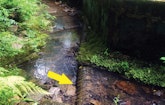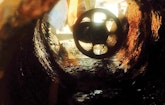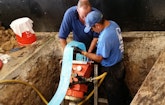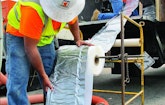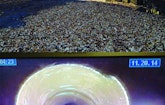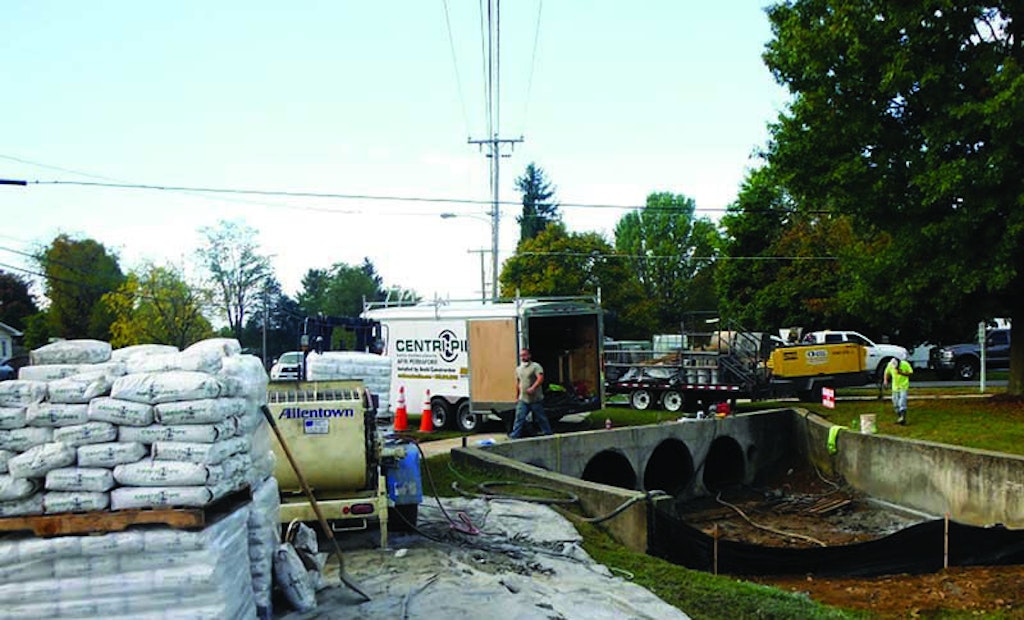Interested in Municipal/Industrial?
Get Municipal/Industrial articles, news and videos right in your inbox! Sign up now.
Municipal/Industrial + Get AlertsLarge culvert rehabilitation project saves money and maintains traffic flow
Problem: An annual inspection in Grottoes, Virginia, uncovered serious problems with the town’s stormwater system. A large set of elliptical CMP culverts did not pass inspection. There was severe corrosion and individual sections were failing and misaligned. The town’s consultants recommended replacement. Complicating the issue, the failing pipes were four parallel culverts that were all quite large — 70 by 44 inches — running directly underneath Dogwood Avenue, one of Grottoes’ two main thoroughfares.
Solution: The town initially obtained cost estimates for replacing the culverts. The price was high and the plan called for significant and lengthy traffic disruptions. Fortunately, Grottoes Town Manager Jeff Nicely had seen a process called CentriPipe at a Rural Water Association conference and thought it could be useful in this situation. The process is based on spincasting technology developed by AP/M Permaform. The spincaster is pulled back through failing pipes while spraying strong, highly adhesive, fiber-reinforced cementitious grout onto the pipe in thin layers. As the layers build up, they form a new, structurally sound concrete pipe within the old pipe. Sewer flow capacity is minimally affected and no annular space is left between the old and new pipes.
Result: CentriPipe provided a trenchless solution, was 15 percent less expensive than digging up the old sewers and replacing them, and saved the town incalculable but significant benefits by eliminating the hassles of disrupted traffic. The new culverts are smooth, seamless, watertight and structurally strong, with a long-projected service life. 800/662-6465; www.centripipe.com.
CIPP renews lateral, spares landmark bridge
Problem: The century-old wastewater lateral between the street and the motherhouse of the Dominican Sisters of Peace in Oxford, Michigan, was well past its life expectancy. Continued treatments for backups due to root intrusion in the lateral’s widening joints were becoming too much for the antiquated pipe to bear.
Solution: The Waterworks, a residential and industrial plumbing firm based in Columbus, Ohio, proposed rehabilitating the lateral with cured-in-place pipe, which would create a durable, impervious pipe with improved flow. They could make the repair in a single shift at a fraction of the cost of open-cut replacement, which had been ruled out for a number of reasons including the need to preserve a historic deck-arch bridge. Source One Environmental of Davison, Michigan, HammerHead Trenchless Equipment’s distributor of HydraLiner CIPP tools and consumables, provided a Super Hydra Inversion Drum, electric wet-out table and lining trailer for the installation, as well as a water boiler. The CIPP consumables consisted of a felt liner, extended cure resin and extended cure hardener. During the inversion process, compressed air forced the resin-impregnated lining from a pressurized inversion drum into the existing pipe. Inversion took only 30 minutes to complete. The crew then inverted an inflation tube inside the felt. Using heated water to activate the resin’s hardener also created hydraulic pressure that forced the lining smoothly and firmly against the sides of the pipe throughout the cure, which took just two and a half hours.
Result: Post-installation video proved the liner held its shape, even bridging past fractures and joints, leaving no deformities. The new 8-inch CIPP rehabilitation has added at least 50 years to the lateral’s service life and ended any need to deal with root intrusion and backups until at least 2064. 800/331-6653; www.hammerheadtrenchless.com.
Point repair system used to restore defective truss pipe
Problem: Mid Mo Environmental of Jefferson City, Missouri, was cleaning and televising an 8-inch reinforced truss pipe for Callaway County and found it needed repairs for three defects — a lateral crack, an abandoned tap and a bad joint — all within a 6-foot-2-inch span, causing severe I&I issues. As with many of these lines, it was under a street and buried more than 10 feet deep.
Solution: Shawn York, owner and certified installer of the Infrastructure Trenchless Point Repair System from Infrastructure Repair Systems Inc., made the decision to restore the three defective areas with a single 7-foot infrastructure point repair liner. Since the damaged area was within 24 feet of the manhole, he devised a 3/4-inch PVC pushrod and pushed the flow-through carrier wrapped with the resin-soaked 7-foot structural fiberglass and felt liner into position to cover all three damaged areas.
Result: Mid Mo’s use of the trenchless single 7-foot repair to cover all three damaged areas saved Callaway County thousands of dollars. Digging and replacing could have taken weeks, and three individual point repairs would have taken one to two days. With the IRSI single point repair there was no disruption of service to customers or the environment. This successful permanent repair was completed in less than three hours. 877/327-4216; http://www.irsi.net.
Manhole adjusting rings save time, increase safety
Problem: The City of Prescott, Wisconsin, had issues with concrete manhole rings failing after just a few years of being in service.
Solution: “I heard of the many successes that LADTECH was having in other cities across the country,” says Hank Zwart, the city’s director of public works. “I changed my specification to allow for LADTECH HDPE adjusting rings to be used in our city.” The riser rings can be installed in minutes. They nest together and include a 2 percent slope ring and a 1/4-inch spacer ring for a precision fit. They’re made of high-density, lightweight recycled polyethylene, meet AASHTO’s HS-25 axle-loading spec, and are impervious to hydrogen sulfide corrosion that destroys concrete. “They weigh only 6 pounds, compared to the 85-pound concrete rings, making them safe to handle and reducing on the job injuries and eliminating the need for heavy equipment,” says Zwart.
Result: Zwart says he expects the rings to be a long-term solution. 877/235-7464; www.ladtech.com.
Pipe rehabilitation liners keep facility open during installation
Problem: Shortly after the Rebound Mental Health facility in Lancaster, South Carolina, opened in January 2014 in a pre-owned building, the original cast iron pipes from 1988 located under slab quickly began to corrode and deteriorate with the sudden increase in usage. The 4- and 6-inch cast iron pipes became prone to constant sewer backups, which required the original contractor to come out each week to jet them. They suggested digging up the floors and replacing all the sewer pipes, which would have required closing the facility for several weeks.
Solution: The customer needed a less intrusive solution that wouldn’t involve digging up the slab or closing the facility. Carolina Pipe Repair proposed to install Nu Drain small-diameter CIPP liners from Nu Flow in all the 4- and 6-inch building drains. Several days were spent removing the years of corrosion and buildup throughout the mainlines. In total, over 500 feet of sewer pipe was relined, including five individual runs of 4-inch pipe and 120 feet of a 6-inch drain. Pipes in the commercial kitchen were also relined without interrupting the continual 15-hour-a-day operation.
Result: The facility stayed fully operational throughout the pipe rehabilitation process, and Carolina Pipe Repair didn’t cause any destruction to the site. 905/433-5510; www.nuflowtechnologies.com.
Inflatable point repair packers solve cured-in-place pipe ailments
Problem: Lametti & Sons was working on an interceptor rehabilitation project in southwest Minneapolis when an issue arose. Very cold soil on a 14,000-foot rehabilitation caused a soft spot near the middle of a run. “It only happens a dozen or so times a year, but when it does we’re in danger of losing the whole lining,” says Project Manager Ross Larson. These soft spots are places where the lining loses stiffness or adhesion, and sags away from the original pipe. Fixing the individual weak spots without compromising or replacing the entire lining is a major challenge.
Solution: Lametti & Sons used an inflatable point repair packer from Petersen Products to fix the failing liner. “We call them steam plugs,” Larson says. “We inserted a 10-inch plug into the liner and pushed it along until it was centered at the soft spot. Then we inflated it with the same steam truck that we used to cure the liner.” When filled with steam, the reusable packers press out against the lining, returning it to round, and apply heat and pressure where it’s needed to recook the lining in place.
Result: “If we didn’t have these, we’d have to improvise something and it wouldn’t be as good,” Larson says. “Because we don’t have to cut out sections or reline, the steam plugs save us thousands every time we use them.” 800/827-5275; www.petersenproducts.com.
Lateral lining system used to rehab collapsed sewer line
Problem: A warehouse facility in San Diego, which houses three businesses, had a 4-inch common sewer drain buried under the floor that was collapsing. One section had collapsed, and the solution offered by other contractors was continued cleaning of the remaining 960 feet of pipe while digging up the 140 feet of collapsed pipe.
Solution: The owner asked Brink Services to look at the situation and see if they could solve the problem and keep the warehouse up and running. The bottom of the cast iron pipe was gone the entire length of the 1,100 feet of pipe, but aside from the collapsed section, it was still round. The biggest problem was the access points, or more specifically, the lack thereof. The shortest line segment was 70 feet, then 289, 141, 140, 220 and 240 feet. Brink Services determined they could employ the Quik Shot lateral lining inversion system from Quik-Lining Systems to make the long lengths between pits, with a 240-foot blind installation at the end. Epoxy resin was chosen to eliminate toxic fumes, along with a 60-minute resin hardener to expedite the project.
Result: The project was completed with no hiccups, on budget and faster than anticipated. The warehouse was able to continue operations uninterrupted. 605/695-6778; www.quiklining.com.
Camera rescued, rehabilitation lining installed under railroad crossing
Problem: A contractor hired by the Pima County Regional Wastewater Reclamation Department in Tucson, Arizona, was inspecting a 12-inch DIP sanitary sewer line under a Union Pacific Railroad crossing, and their CCTV camera was stuck in a section of the pipe that was partially deteriorated. The county asked all three of their JOC contractors to offer their best plan for getting the camera out. Achen-Gardner Construction’s plan was chosen and work began immediately.
Solution: Achen-Gardner Construction sent a camera down the line and used a rodding machine with a hook attachment to extract the stuck camera and associated cables. Crews then video inspected both sides of the deteriorated section to determine the line was clear of debris and could be lined. Crews successfully lined the entire 385 feet of 12-inch pipe using Reline America’s ALPHALINER in one of the busiest industrial intersections in Pima County. The team coordinated with Union Pacific Railroad and Tucson Electric Power, which has a large facility next to the job site, to perform this work quickly and safely. The team worked 24/7 to complete the work before Christmas.
Result: After the new year, crews returned and completed a second shot of the line per Pima County’s request. This was done due to the extremely poor condition of the original host pipe and to provide additional protection to accommodate railroad standards. The lining system has performed as advertised. 866/998-0808; www.relineamerica.com.
Point repair leads to significant cost and time savings
Problem: In Mayfield, Kentucky, a 10-inch vitrified clay pipe was missing a 4-foot section, causing heavy, continuous I&I. A small, concrete bridge with an 18-inch storm drain crossing the sewer line sat above the pipe. Traditional dig-and-replace methods would have forced the city to bypass both sewer lines, completely rebuild the bridge and close the road, with estimated costs between $25,000 and $30,000.
Solution: The city, hoping to avoid a long and expensive excavation, turned to Source One Environmental to provide a trenchless repair solution for the missing pipe. The company used the PipePatch point repair system and installed two 10- by 48-inch repairs. The repairs overlapped by 1 foot, allowing the team to utilize the existing solid pipe to re-establish structural strength and prevent further damage.
Result: The trenchless system restored all structural integrity to the damaged pipe. It created a pipe within a pipe, as the fully cured resin and fiberglass formed a structural barrier between the pipe interior and the exterior environment. The original inside diameter of the pipe was only affected by 1/8 inch. The entire installation process took five hours, three people and a fraction of the estimated cost. 877/450-3701; www.s1eonline.com.
Lining system used to rehabilitate failing iron sewer pipe
Problem: The owners of the Pine Grove Resort in northern Wisconsin needed to reline a deteriorated cast iron sewer pipe under concrete flooring without digging up the floor. The sewer is approximately 70 feet long and 5 to 6 inches in diameter. Heavy tuberculation made rehabilitation a challenge.
Solution: Great Lakes TV Seal, in cooperation with Trelleborg Pipe Seals Milford, delivered one of its no-dig CIPP solutions using the DrainPlusLiner 2.0 and EPROPOX HC120+ resin system. This was the first installation of its kind in the country. The silicone-coated, heat-resistant and highly flexible liner allows for up to two nominal diameter changes in the internal host pipe and can travel almost wrinkle-free through 90 degree bends in the sewer, providing reliable stability even in over-expansion areas. As the liner and resin system are coordinated to be steam cured, this solution offers significant time savings. Once the temperature reaches 176 degrees F, it takes just approximately 45 minutes to achieve the optimal mechanical properties and a sustainable rehabilitation result. Suitable for pipes and sewers from DN 70 / 3 inches to DN 250 / 10 inches, DrainPlusLiner 2.0 is universally applicable for vertical and horizontal pipelines. It only requires low pressure during installation and curing.
Result: The trenchless pipeline and sewer rehabilitation methods were a practical and economical alternative to complete replacement. Major construction and disruption to the hotel was avoided, and business wasn’t affected. 800/626-2180; www.trelleborg.com/pipe-seals.

